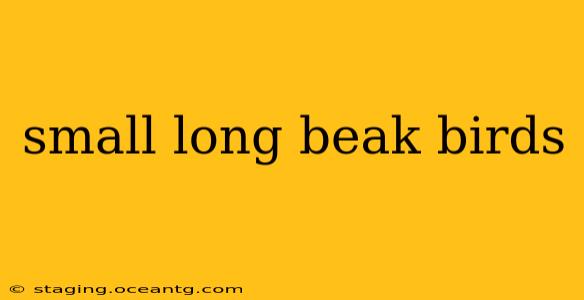Many small birds boast impressively long beaks, each perfectly adapted to its unique diet and lifestyle. This comprehensive guide explores various species, highlighting their distinctive features, habitats, and fascinating feeding behaviors. Understanding these adaptations helps us appreciate the incredible biodiversity of the avian world.
What are some examples of small birds with long, thin beaks?
Several small bird species feature long, thin beaks, each serving a specific purpose. A few notable examples include:
- Sunbirds: These nectar-feeding birds, found primarily in Africa, Asia, and Australia, possess long, slender beaks ideal for probing flowers and extracting nectar. Their beaks are often curved to reach deeper into blossoms.
- Honeycreepers: Native to Hawaii, these vibrant birds also have long, curved beaks adapted for nectar feeding. However, different species exhibit beak variations reflecting their specialized diets, some with longer, more decurved beaks than others.
- Avocets: While not strictly "small" birds, Avocets are relatively small compared to some wading birds and possess exceptionally long, upturned beaks. This unique beak shape allows them to sift through shallow water, filtering out small invertebrates.
- Needle-tailed Swifts: These aerial insectivores have long, needle-like beaks perfect for catching insects in mid-air. Their streamlined bodies and long wings complement their specialized beaks.
- Certain species of Warblers: Some warbler species, while variable in size, can exhibit relatively long, slender beaks, useful for probing for insects in crevices or within vegetation.
What kind of beak does a hummingbird have?
Hummingbirds are renowned for their exceptionally long, slender beaks, which are perfectly adapted to their nectar-feeding lifestyle. The beak length varies among hummingbird species, correlating with the shape and depth of the flowers they frequent. The long, thin beak allows them to reach the nectar deep within the flowers inaccessible to other birds.
What is the purpose of a long beak in a small bird?
The purpose of a long beak in a small bird is primarily related to its diet and foraging strategy. The length, shape, and curvature are all crucial adaptations:
- Nectar feeding: Long, slender, often curved beaks are perfect for reaching nectar deep within flowers.
- Insect probing: Long, thin beaks allow for probing crevices, bark, or leaves to extract insects.
- Aquatic foraging: Long, often upturned, beaks aid in sifting through mud or water to capture invertebrates.
- Specialized diets: Different beak shapes reflect specialized diets, showcasing the remarkable diversity of avian adaptations.
What small birds have long beaks and eat insects?
Many small birds with long beaks are insectivores. Examples include:
- Certain species of woodpeckers: While some woodpeckers are larger, several smaller species utilize their long, sharp beaks to drill into wood and extract insect larvae.
- Some warblers: As mentioned earlier, some warblers use their long beaks to probe for insects in foliage.
- Long-billed wrens: Their long beaks help them forage for insects in dense vegetation.
How can I identify a small bird with a long beak?
Identifying a small bird with a long beak requires careful observation. Pay attention to:
- Beak length relative to body size: How long is the beak compared to the bird's overall length?
- Beak shape: Is it straight, curved, or upturned?
- Habitat: Where is the bird found? Different habitats support different species.
- Behavior: How does the bird forage? Observe its feeding techniques.
- Plumage: While not directly related to the beak, plumage can help narrow down the possibilities.
This detailed guide provides a starting point for understanding the incredible diversity of small birds with long beaks. Further research into specific species will reveal even more fascinating insights into their adaptations and behaviors. Remember to always observe birds responsibly and respectfully from a distance.
